A third oil and gas explorer is in the early stages of assessing the Clipper prospect for deep-water test-drilling off the coast of Oamaru, having committed to a large $5 million to $10 million shipborne seismic hydrographic survey, beginning early next year.
New Zealand Oil and Gas (NZOG) will find out shortly if it gets ministerial approval to become a 50:50 partner with permit-holder Beach Petroleum, and subsequently become the Clipper prospect's exploration operator.
Shows of oil and gas have been found from the test-drilling of five holes in the area since 1970, around the prospects Clipper, Cutter, Endeavour, Resolution and Galleon, but none in commercially viable quantities, the last being Ocean Patriot's one-hole programme off Oamaru in late 2006.
NZOG chief executive Andrew Knight said that, subject to gaining approvals, earlier 2-D data would be reprocessed. The company was in the process of contracting a seismic vessel for a more definitive 3-D programme.
Oil giant Anadarko this week committed to a drilling programme of up to $US100 million ($NZ127 million) off Otago's coast in January, while Shell is in the final weeks of considering a $US200 million programme off Otago, where it believes it has a 30% chance of finding gas.
Mr Knight was reluctant to put a percentage estimate on either the expected presence of oil or gas, but said the science of data collating was working towards a minimum 20% success rate.
''In our portfolio [of prospects] across the country we try to get to [a likelihood of] 20% drilling success. At present, we are well below that [at Clipper],'' Mr Knight said when contacted yesterday.
The seismic survey was relatively large, covering 700sq km, compared with recent Taranaki seismic surveys of 300sq km and 500sq km, and would cost $5 million to $10 million, Mr Knight said.
The survey was expected to take 20 to 30 days and had to be completed by April, dictated by the likely weather conditions.
NZOG has eight prospects around the country, and Mr Knight confirmed none of the work on them, either by seismic ships or oil rigs, dovetailed with the estimated work programme for Clipper, but there was the potential to collaborate with other companies and align programmes to save money.
Although other wells had not found commercially viable quantities of oil and gas, Mr Knight was bullish about the area, saying he considered it a ''working hydrocarbon region'', with oil seeps around Moeraki and other gas seeps in the region.
''It [Clipper] is still very much a scientific concept at present,'' he said.
NZOG's Clipper programme is to analyse the 3-D data during the latter half of 2014. It would then update overall basin analysis and make a decision by March 2016 on whether to drill, or drop its permit holding, with a ''one-well'' programme pencilled in for between April to September that year.
Late last month, NZOG reported a 17% decline in operating profit, from $70.5 million a year ago to $58.8 million.
Revenue, operating earnings, which include exploration costs, and normalised profit fell as the offshore Taranaki Tui oilfield entered its decline phase and the offshore Kupe gas and oilfield was shut down for maintenance during the year.
Total revenue fell almost 15% to $99 million but operating costs only fell 8.4%.
NZOG wrote off $15.1 million of exploration costs and $22.4 million of depreciation and amortisation, reporting earnings before interest and tax of $21.3 million, down almost 47% on a year ago.





